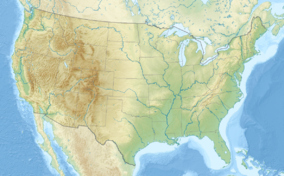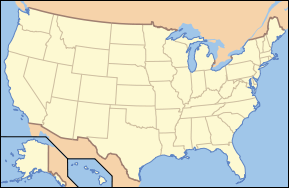- Colonial National Historical Park
-
Colonial National Historical Park IUCN Category V (Protected Landscape/Seascape)
Fusilier's Reboubt Overlook, York CountyLocation York and James City counties and Williamsburg, Virginia, USA Nearest city Williamsburg, VA Coordinates 37°13′8″N 76°31′3″W / 37.21889°N 76.5175°WCoordinates: 37°13′8″N 76°31′3″W / 37.21889°N 76.5175°W Area 9,349.28 acres (3,783.52 ha), 9,271.30 acres (3,751.96 ha) federal Established December 30, 1930 Visitors 3,346,675 (in 2007) Governing body National Park Service and Preservation Virginia Colonial National Historical Park is located in the Hampton Roads region of Virginia and is operated by the National Park Service of the United States government. Over 3 million people visit the park each year.
Contents
Colonial Parkway
Main article: Colonial ParkwayThe park includes the Colonial Parkway, a scenic 23-mile (37 km) parkway linking the three points of Virginia's Historic Triangle: Jamestown and Yorktown and running through the historic district of Colonial Williamsburg. The Colonial Parkway is located in James City County, York County, and the independent city of Williamsburg.
Jamestown
Main article: Historic JamestowneThe park includes the original site of Jamestown known in modern times as Historic Jamestowne. Located in James City County at the southern end of the Colonial Parkway, it encompasses the area of Jamestown Island and is adjacent to the Commonwealth of Virginia's complementary attraction known as Jamestown Settlement.
Yorktown
At the northern end of the Colonial Parkway, in York County at Yorktown, the park operates the Yorktown Battlefield. The Nelson House, which was built around 1724, may have served as Cornwallis’s headquarters during the final battle of the Revolutionary War, and the battlefield was the site of the British defeat. Both the house and the historic siege earthworks were restored in 1976.[1] Nearby, the state-operated Yorktown Victory Center and the Yorktown Riverwalk Landing area are located.
Green Spring Plantation
Sir William Berkeley, who held the colonial governorship during the longest periods of any individual, used his Green Spring Plantation as an experimental farm to attempt to develop sources of income for the colony other than cultivated tobacco and traded furs.
The preserved portion of the site of Green Spring has been largely untouched since the second dwelling there and dependencies were destroyed during the American Civil War (1861–1865), promising a rich archaeological dig area to follow upon recent discoveries at the Park's location on Jamestown Island.
Cape Henry Memorial
The Cape Henry Memorial, site of the first landing of the Captain Christopher Newport and the soon-to-be Jamestown colonists in 1607, is located in the city of Virginia Beach, Virginia at Cape Henry. Open to the public, it is located off U.S. Route 60 on the army base of Fort Story.
Administrative history
Colonial National Monument was authorized on July 3, 1930. It was established on December 30, 1930. On on June 5, 1936, it was redesignated a national historical park. The cemetery at Yorktown was transferred from the War Department to the National Park Service on August 10, 1933.
Jamestown National Historic Site, is co-owned by the National Park Service and Preservation Virginia (formerly known as the Association for the Preservation of Virginia Antiquities) and administered by the NPS, was designated on December 18, 1940. Preservation Virginia owns 22 acres (89,000 m2) containing the remains of the original 1607 fort. The National Park Service owns the remaining 1,178 acres (4.8 km2) of the island which contains the archeological remains of the expanded towne and its island plantation sites.
As with all historical areas administered by the National Park Service, Colonial National Historical Park and Jamestown National Historic Site are listed on the National Register of Historic Places of the U.S. Department of the Interior.
References
- ^ "Walter Eugene George, Jr. Collection: 1951-2007", Alexander Architectural Archive, University of Texas at Austin Libraries. Retrieved 2010-11-29.
External links
- Official NPS website: Colonial National Historical Park
- Cape Henry Memorial
- Green Spring Plantation
- Friends of Green Spring a large interactive web site with streaming video and essays ("The voices of Green Spring")
- Jamestown National Historic Site
- Yorktown Battlefield
- Yorktown National Cemetery
- Yorktown National Cemetery - a roster and photo of burials
- More information on the Battle of Yorktown
U.S. National Register of Historic Places Topics Lists by states Alabama • Alaska • Arizona • Arkansas • California • Colorado • Connecticut • Delaware • Florida • Georgia • Hawaii • Idaho • Illinois • Indiana • Iowa • Kansas • Kentucky • Louisiana • Maine • Maryland • Massachusetts • Michigan • Minnesota • Mississippi • Missouri • Montana • Nebraska • Nevada • New Hampshire • New Jersey • New Mexico • New York • North Carolina • North Dakota • Ohio • Oklahoma • Oregon • Pennsylvania • Rhode Island • South Carolina • South Dakota • Tennessee • Texas • Utah • Vermont • Virginia • Washington • West Virginia • Wisconsin • WyomingLists by territories Lists by associated states Other  Category:National Register of Historic Places •
Category:National Register of Historic Places •  Portal:National Register of Historic Places
Portal:National Register of Historic PlacesNational Historical Parks of the United States Abraham Lincoln Birthplace • Adams • Appomattox Court House • Boston • Cane River Creole • Cedar Creek and Belle Grove • Chaco Culture • Chesapeake and Ohio Canal • Colonial • Cumberland Gap • Dayton Aviation Heritage • George Rogers Clark • Harpers Ferry • Hopewell Culture • Independence • Jean Lafitte • Kalaupapa • Kaloko-Honokōhau • Keweenaw • Klondike Gold Rush • Lewis and Clark • Lowell • Lyndon B. Johnson • Marsh-Billings-Rockefeller • Minute Man • Morristown • Natchez • New Bedford Whaling • New Orleans Jazz • Nez Perce • Palo Alto Battlefield • Paterson Great Falls • Pecos • Puʻuhonua o Hōnaunau • Roosevelt Campobello International Park • Rosie the Riveter/World War II Home Front • Salt River Bay • San Antonio Missions • San Francisco Maritime • San Juan Island • Saratoga • Sitka • Thomas Edison • Tumacácori • Valley Forge • War in the Pacific • Women's RightsFull Alphabetical List Categories:- IUCN Category V
- American Revolutionary War sites
- Archaeological sites in Virginia
- Parks in James City County, Virginia
- National Historical Parks of the United States
- National Register of Historic Places in Virginia
- Parks in Williamsburg, Virginia
- Parks in York County, Virginia
- Parks in Virginia
- Protected areas established in 1930
- United States National Park Service areas in Virginia
- Museums in York County, Virginia
- American Revolutionary War museums in Virginia
- Parks in Virginia Beach, Virginia
Wikimedia Foundation. 2010.



